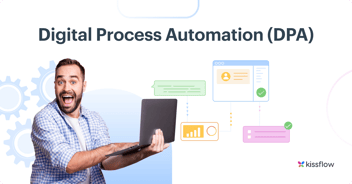Related Articles

Team Kissflow
Updated on 19 Jun 2025 • 5 min read
In today’s increasingly digital world, businesses must learn to pivot and digitally transform their operations to maintain a competitive edge. When it comes to digital transformation initiatives, two key concepts have emerged: digitization and digitalization.
More than just being buzzwords often used interchangeably, both concepts are stepping stones to digital transformation. They encourage organizations to adopt a digital-first mindset, improve agility, and nurture innovation in the workplace.
But how are these two concepts different from each other? Let’s compare process digitization vs. process digitalization.
Business process digitization isn’t just about going paperless. It’s also about leveraging digital tools to create optimized solutions that promote greater efficiency in the workplace.
Digitization converts analog or paper processes into digital processes without altering the data. An example is converting paper copies of patient records into digital files to manage patient care and discharge procedures more seamlessly.
Digitizing important documents helps businesses retrieve files faster, enhance security through measures like encryption, save on resources, improve file longevity, and create digital backups for data recovery.
Effective Business Process Management (BPM) serves as the foundation for both process digitization and digitalization, enabling organizations to optimize workflows, enhance efficiency, and drive digital transformation.
Businesses implementing digitization unlock substantial benefits, such as:
As NQ Dry Tropics grew, they faced the challenge of tracking expenses. With email and paper-based manual processes, tracking expenditures took a lot of work.
After digitizing their purchase requisition process with Kissflow, they could efficiently track their expenses, save costs by minimizing unnecessary spending, and eliminate time-consuming manual work.
It's important to note that while digitizing processes can enhance operational efficiency and reduce errors, it doesn’t alter the business itself, which is something digitalization does.
Digitalization in business involves using digital technologies to transform internal processes, create new revenue opportunities, and produce more business value.
It builds on digitization by eliminating manual or paper-based processes. However, the scope of digitalization is much wider than that. It leverages data and analytics to transform interconnected processes into streamlined and automated workflows.
“The goal of automation is not to dehumanize operations but rather to reprioritize them such that the most effective elements of human creativity can shine at all levels of an organization,” says Forbes Council Member Steve Smith.
Digitalization enables businesses to:
Below are case studies showing how digitalization has helped businesses across industries transform their business processes.
Rafic A Kreidie Engineers & Contractors struggled with delayed approvals and an overwhelmed IT team. They often had difficulty tracking requests due to paper-based forms. Digitalization powered by Kissflow allowed them to create structured and automated processes, reducing the burden on their IT team and improving accountability and transparency on a broader scale. Approvals also became quicker, and procurements got done on time.
Lima Cargo City relied on manual processes, making it challenging to track and maintain information. It also resulted in information redundancy, data errors, and communication issues.
By achieving process digitalization with Kissflow, they could communicate with suppliers and customers in real-time. They could also streamline internal processes like budget management and safety permit management. Digitalization helped enhance information accuracy and customer satisfaction.
While both concepts are tech-driven and leverage data, they have some key differences.
Digitization focuses on converting data from analog or manual sources into digital equivalents. It aims to automate processes and reduce the need for physical work. It can transform business processes, enhance customer experiences, aid in developing new products or services, and improve overall efficiency.
Meanwhile, digitalization is about using digital solutions, such as software and applications, to improve business processes. Through digitalization, organizations can streamline and enhance their internal and external communication, optimize workflows, and uncover new opportunities for organizational growth.
Digitization makes changes on a task level, improving transparency and connectivity.
Meanwhile, digitalization affects the entire organization. Through digitalization, organizations become more agile and responsive to the ever-evolving business landscape and customer needs. They can uncover new opportunities for innovation and build new, disruptive business models to gain a competitive edge.
Digitization makes data accessible and centralized while minimizing errors and the need for manual work.
On the other hand, digitalization helps digitize and transform internal processes across the organization, improving efficiency and productivity. It can have a significant positive impact on productivity, employment, risk reduction, and business development. Organizations can be better positioned and become more digitally mature by adopting digitalization.
The pandemic has dramatically transformed operations, pushing 85 percent of businesses to accelerate their use of technologies and enable digital collaboration. It has resulted in the rapid digitization of end-to-end processes.
Below is a quick step-by-step guide for implementing process digitization.
An in-depth understanding of business processes allows you to develop a comprehensive strategy focused on your organization’s specific goals for digitization. It helps identify which stages of the customer experience should be digitized and determine which capabilities are needed to execute digitization.
You’ll need to step back and determine what your business should look like. You can do this by performing a workflow analysis and identifying which processes could benefit from digitization. Do you have processes that are prone to human errors? How long does it usually take for a certain task to be completed?
Once you’ve identified the digitization use case, you must document your current process to identify recurring issues.
Next, you must select a process digitization tool that meets your organization’s needs. When you’re ready to digitize processes, involve key players like stakeholders and users who will directly benefit or be affected by this new process. Designate roles and responsibilities before integrating the digitized process with your existing solutions.
After implementing the digitized process, evaluate its performance and continue optimizing it. Lastly, take your digital processes live to make them accessible to everyone.
87 percent of business leaders say that digitalization is a top priority. However, only 40 percent of organizations have been able to implement their digital initiatives successfully.
Here are the steps to achieve successful process digitalization:
A digitalization strategy for business transformation requires organizations to define their digital ambition and set clear, measurable goals. Identify digital initiatives that need to be prioritized and their expected business outcomes.
Choose a platform that can address the current problems in business operations and allow for flexibility. When bringing in new technology, consider the level of familiarity that business users have with it. Educate users about the new technologies along with the main features and benefits.
Take steps to ensure that both company and customer data are protected. Before implementing process digitalization, you should develop a comprehensive security strategy. Look for new opportunities to improve existing business processes and models through digitalization.
Lastly, leverage data to identify areas of improvement so you can continue to tweak digital processes, eliminate bottlenecks, and ensure everything is running smoothly.
Building your organization’s digital capabilities is crucial for the success of process digitization and digitalization initiatives. When acquiring digital talent, look at your talent pool before contacting external specialists. Check to see if enough people have a good grasp of the digitization and digitalization initiatives and whether you have employees with the resources and skills to help with implementation.
To build and nurture a culture of creativity and innovation, you must educate and encourage business users to find new ways to use new technologies to solve their problems and make your organization more agile.
Learn More: Business Process Management
Low-code platforms are changing how businesses approach the process digitization and digitalization debacle. Kissflow is a comprehensive low-code platform designed to help organizations streamline their digital transformation efforts, transform crucial business processes, and enhance operational efficiency.
Kissflow allows organizations to digitize and digitalize their business processes, helping them achieve digital transformation. You can unlock new growth opportunities for Kissflow, paving the way for citizen developers and optimized business processes.
From digitizing manual processes to transforming core business functions through digitalization, Kissflow can accelerate your digital transformation journey.
Leverage the Kissflow low-code platform to supercharge innovation and creativity in the workplace today.
Related Articles
Welcome.
Let's get started.
To begin, tell us a bit about yourself
By proceeding, you agree to our Terms of Service and Privacy Policy
"The beauty of Kissflow is how quick and easy it is to create the apps I need. It's so user-friendly that I made exactly what I needed in 30 minutes."
Oliver Umehara
IT Manager - SoftBank
A Trusted Choice for Companies Globally




Thank you for signing up
Someone from our team will contact you soon.

Know why all the IT leaders converging at booth #602
Earn a chance to be part of our experience event

Get the first look at the 2024 Citizen Development report
Welcome.
Let's get started.
By proceeding, you agree to our Terms of Service and Privacy Policy
Wondering where to start?
Let's talk!
Connect with our solution experts to gain insights on how Kissflow can help you transform ideas into reality and accelerate digital transformation

This website uses cookies to ensure you get the best experience. Check our Privacy Policy


